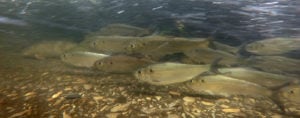Department of Defense will filter PFOS discharges to sewers – not to Newburgh’s drinking water supply
On April 6, 2018, nearly two years after the City of Newburgh’s drinking water crisis came to public attention, the 105th Airlift Wing of the New York Air National Guard awarded a $82,355 contract for a carbon filtration system to remove PFOS from its wastewater.
On its face, this sounds like what citizens, Riverkeeper, the city, the state, and elected representatives at every level of government have called for. The toxic PFOS — a chemical used in firefighting foam spilled at the Air National Guard Base — discharges through the base’s stormwater pipes to streams that feed Washington Lake, the City of Newburgh’s primary reservoir. Treating the pollution at that point of discharge is an immediate step that can and should be taken to reduce the threat downstream, while long-term remediation plans are implemented. Riverkeeper has called for such an “interim remedial measure,” as it is known, since the earliest days of the crisis.
But despite the clear, consistent and loud call for action, installing such a filter is not what the Air National Guard aims to do. Instead, it requested proposals for a project that would treat wastewater from lagoons at the base, which discharge through public sewers to the Town of New Windsor’s wastewater treatment plant.
As Shantal Riley reported in Mid Hudson Times on April 4, 2018, “The town [of New Windsor] required the wastewater to test ‘non-detect’ for PFOS and PFOA – with less than 2 parts per trillion of the chemicals – before it could be routed to the town’s wastewater treatment plant.”
How could a sewer plant have authority to stop discharges that a drinking water supply doesn’t?
Under the Clean Water Act’s pollution discharge permitting program, municipalities can obtain some authority to regulate industrial discharges to public sewers that end up at the local sewage treatment plant. That authority comes from an approved “pretreatment program” which requires the municipality to monitor and set limits on industrial discharges, even if those limits are more strict than state or federal limits. New Windsor has an approved pretreatment program, so once the Town told the Air National Guard Base it would not accept waste with detectable levels of PFOS at its treatment plant, the base acted to stop the polluted discharges from getting into the public sewers.
The Town of New Windsor has the Clean Water Act at its back to stop toxic PFOS discharges. The City of Newburgh, backed by a small army of citizens, advocates, regulators and elected officials, has been unable to achieve the same result for the its drinking water supply.
The other inescapable fact is that PFOS has undoubtedly been discharged for years or decades to the Hudson River, as it traveled through public sewers from the Air National Guard Base to the Town of New Windsor Treatment Plant. The plant discharges to the Moodna Creek, just above its confluence with the Hudson River. The Moodna Creek, which reaches the Hudson at the unspeakably gorgeous park at Plum Point, is a state-designated Significant Coastal Fish & Wildlife Habitat, in part because the creek and the flats at its mouth are important spawning areas for river herring, American shad and striped bass. These species — which are, as I write, spawning in our estuary as part of one of the world’s great wildlife migrations — spend most of their lives in the Atlantic Ocean. Sewage treatment plants aren’t built to remove PFOS, pharmaceuticals or any number of other unregulated contaminants, and they don’t. No doubt generations of spawning fish, their eggs and young fish that populate our ocean have been doused with toxic PFOS from Stewart Air National Guard Base.
Boaters in Newburgh Bay at the height of striped bass season, May 2014. (Photo by Dan Shapley / Riverkeeper.)
The state now advises against eating any fish from portions of the Moodna Creek Watershed downstream of the Air National Guard Base and Stewart International Airport, another, if lesser, source of PFOS. What risks are there to anglers now lifting striped bass from Newburgh Bay? Who can say?
But that’s an outrage for another day. Today is the second anniversary of Newburgh’s drinking water crisis, and there’s outrage enough over the injustice of the Department of Defense acting more quickly to stop toxic discharges to a public sewer than to the drinking water supply for a city of 29,000 people.


